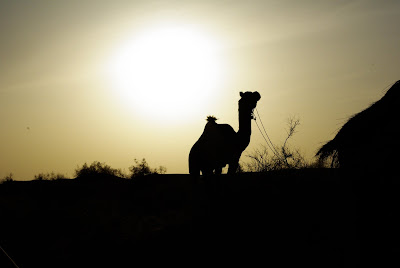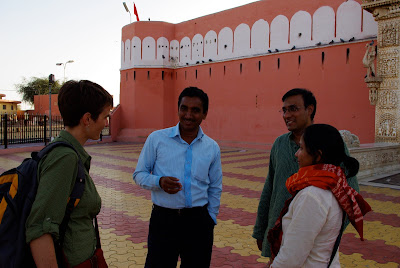March 12, 2010
Today is a very exciting day. Going into the desert on camel-back is something the both of us have fantasized about since the first time we saw ‘Lawrence of Arabia’. How cool to be Peter O’Toole for a day!
We all got up this morning and put on our desert gear. Pure cotton traditional Indian dress in a light color is the best choice as the cotton is cool yet protects you from the scorching sun (it will be 100 degrees today). Charanya and I put on our salwar cameez and Shrikant his kurta. Rowan opted for the SPF infused outdoor western clothing in that new technical wicking fabric. A head scarf (hijab) is essential to keep your head from getting fried to a crispy crunch. We ate a hearty breakfast and off we went in our jeep to meet our Raikas (camel tenders) to start our journey into the desert. We will be provided with camels, Raika guides, a camel-pulled cart to carry our provisions (water, food, cooking stove, utensils, etc.). The first order of business for our head Raika was to instruct us on how to get on and off of a camel. Camels are HUGE animals, so this is no easy task, as you will see.
No, these are not terrorists, they are Jenni, Rowan and Charanya wrapped up in their hijab. :o)
Our man Shrikant
Watching someone get on a camel and staying on as the camel rises from its knees is funny.
After we were instructed on how to stay on the camels and all of our provisions were put into the camel carts, we set off into the Thar Desert. Get ready for camel toes :o)...Drum roll please...........
OK, so Jenni is giving it a SERIOUS Katharine Hepburn in that get-up. She forgot this isn't the African Queen, but the Thar Desert! :o)
As we began our journey, the landscape was covered with small scrub bushes and very dry looking trees. We learned that these trees have roots that dive over 200 feet deep to reach water. That is how they survive in this arid environment. We passed a couple of camel carts coming into town from the desert on our way out. This is the main transport for the desert people.
A few photos of our journey out.
After just over an hour on camel-back we came to this tiny village called Sentasa. Our Raika's asked us if we would like to stop here for some tea and a visit to a traditional desert home. In the interest of our behinds, we said yes. :o)
As we came into town, we were met by some of the village goats.
The camels found the well right away and went for a long drink. We learned that most villages across the desert are there because water has been found at that spot or within walking distance. The water you see here would be the main water source for the village.
How to stay on a camel when it is sitting down. I was surprised I could actually walk once I got off of that beast.
Village photos
We were welcomed into a house so we could see how these people live. Our guide took us in and explained to us how these villagers keep their food from spoiling in the intense heat. There are special huts built with extra thick mud walls, and no windows, for storage of grains, potatoes, onions, etc. Here is a video of our guide explaining in Hindu about the hut (Shrikant then translated what he said for us into English).
It is amazing how a hot cup of tea can actually cool you off in the desert heat
It is high fashion to shave your camels hair into intricate designs. Every camel we have seen so far is decorated like this.
How a camel takes a sand bath
After our short rest stop in the village, we got back on our camels and continued our journey into the desert. As we were leaving the village, a sheep herder passed us on the road. It's hard to imagine there is anything for these sheep to eat out here in this barren land, but they do survive. Our next stop will be for lunch.
Where we are headed........
More coming. Stay tuned...........
















































